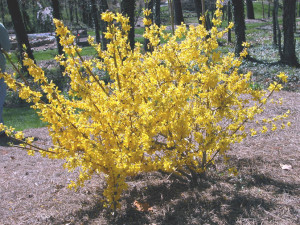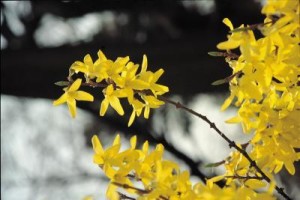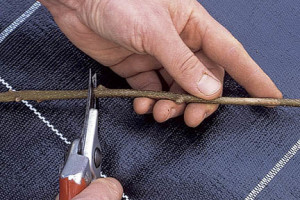Cutting Propagation for Forsythia x intermedia
http://bioimages.vanderbilt.edu/tsn/32963
Introduction
Forsythia (Forsythia x intermedia) gets it name from the great Scottish botanist William Forsyth (1737–1804). Forsyth was royal head gardener and a founding member of the Royal Horticultural Society. The Forsythia genus is part of the larger Oleaceae family (olive family). Eleven species make up the genus, most of which are native to Eastern Asia. Forsythia × intermedia was introduced to Europe in 1880 as a hybrid of F. suspensa and F. viridissima. Of the 11 species in the Forsythia genus, the two most commonly cultivated for ornamental use are Forsythia × intermedia and Forsythia × variabilis. They are very similar in appearance and behavior, both producing yellow flowers in the early spring.
Forsythia x intermedia can grow to a height of 8–10′ and 10–12′ wide at maturity. It boasts 3” to 5”, simple leaves, ovate to oblong-lanceolate in shape, fashioned in an opposite pattern. Each leaf is toothed along the upper portion of the margin and brandishes a dark green color. Branches of the plant tend to grow in an upward arching pattern creating an overall rounded shape. Growers often plant the shrub as an ornamental hedge due to its size and its beautiful bell shaped flowers that are produced in early spring.
Forsythia x intermedia can be found in almost every state in the United States, occupying hardiness zones 5-8. Many choose to plant it because it is rugged and reliable. This shrub is very popular in gardens and parks in the early spring during flowering. Many also plant Forsythia x intermedia because it is able to occupy both acidic and alkaline soils that are either loamy, sandy, or silty loam. Soils must be well drained, but rich enough to retain some moisture. When deciding where to plant, the amount of sunlight the area gets should be taken into consideration. A minimum of 4 hours of unfiltered sunlight must be able to reach the plant per day. Also, if a hedge is being planned, 4’ to 6’ spacing between plants should be used to ensure that each individual plant has the space it needs to grow. If the size of the shrub becomes unsatisfactory, it may be pruned without the worry of causing harm. The best time to prune however is immediately after flowering. Being that Forsythia x intermedia is deciduous it loses its leaves in the fall and grows new ones in the spring.
Propagation
Forsythia x intermedia is considered to be an easily propagated plant. The two most common ways propagating this shrub are by cuttings and layering. Layering is done by simply scarring and burying the middle portion of a branch in the ground while it is still attached to the plant. This is where the new roots will form. A 3” or 4” portion of the tip of the branch should be left unburied. The tip will become the new plant and once rooting occurs the connection to the mother bush should be cut. A post of some sort may have to be used to keep the middle portion buried. There are other methods that can be used for propagation such as tissue culture and grafting, but due to the ease and inexpense of the layering and cutting methods these techniques are rarely used. In tissue culture, a small portion of the plant is placed in a certain type of media and grown. It is costly and uneconomical. Grafting is more economical, however it takes skilled workers that demand a higher salary than workers who are unfamiliar with grafting techniques.
Softwood or hardwood cuttings are able to be taken from Forsythia x intermedia and propagated. The hardwood cuttings (growth older than a year) can be put into a nursery row in late winter or early spring. Softwood cuttings (growth within the last year) with leaves can be taken during the latter half of spring and rooted under intermittent mist. The difference between the two is softwood is actively growing, while hardwood is dormant. Hardwood cuttings tend to be more commonly taken and the steps for taking them are listed below.
Steps
1) Selection of a Healthy Stock Plant and Timing
Cuttings can be taken anytime after the first frost until late winter when the flower buds begin to swell. The first step in taking a cutting of Forsythia x intermedia is to select a plant that looks healthy and vigorous. Look for a branch that has light brown bark with a green tint to it. This branch should have healthy looking buds, internodes that are not abnormally long, and preferably not be from a weak interior shoot. Generally, try to avoid taking cuttings of branch tips as these usually contain unwanted flower buds. For the best results, choose medial and basal cuttings. The cutting should contain at least 3 nodes and can be anywhere from 5 to 12 inches in length.
2) Making the Cut
A pair of sterilized pruning clippers should be used to make the cuts. This will help prevent any infection from pathogens. The proximal end should be cut straight across and the basal end should be cut at an angle. This will help later with identifying which end should be placed in the media. About a half inch to inch of stem should be left at the basal end of the cutting after the node.
3) Adding a Hormone
This step is optional as Forsythia x intermedia is known to produce roots without the help of hormones, however the use of rooting hormones greatly decreases the waiting period for roots to form. If choosing to use a rooting hormone it is recommended that once the cutting is taken the basal end should be dipped in an IBA solution at 2,500 to 5,000 ppm concentration.
4) Initiating Roots with Bottom Heat
There are a variety of ways this step can be done and other options should be explored if this technique does not seem suitable. Once the cuttings have been taken and/or treated with a rooting hormone they are to be bundled and placed upright in an 8 inch sand base with 3 inches of moist peat on top for about 4 weeks or until roots emerge. Heating mats should be placed under the sand base and maintained at a temperature of 65 to 70 degrees fahrenheit. Sheds that are covered and unheated are the best place for cuttings to be kept. Be careful to not overwater because this could lead to rotting.
4) Transplanting
When roots start to emerge it is time to think about transplanting. Transplanting should be done in early spring before buds begin growth. Plants should be transplanted into a nursery to continue their development. If conditions are not suitable once rooting begins the cuttings can be left under protected culture, in the rooting bed, with the bottom heat shut off until conditions improve.
5) Selecting a Place to Plant
After about a week or two in a nursery the Forsythia x intermedia should be ready to plant anywhere. This shrub tends to grow quite large, so maintaining enough space for mature growth should be kept in mind when selecting a spot.
Work Cited
Evans, E., & Blazich, F. (1999, January 31). Plant Propagation by Stem Cuttings: Instructions for the Home Gardener. Retrieved October 8, 2015, from http://content.ces.ncsu.edu/plant-propagation-by-stem-cuttings-instructions-for-the-home-gardener/
Forsythia: Forsythia x intermedia. (2015). Retrieved October 8, 2015, from https://www.arborday.org/Trees/treeguide/TreeDetail.cfm?ItemID=840
Hartmann and Kester’s Plant Propagation: Principles and Practices, Hartmann H. T., Kester D.E., Davies F.T., Geneve R.L., 8th Edition. Pgs 345,347,354,365,367,541,793



